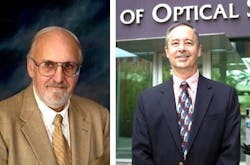National Academy of Inventors welcomes two University of Arizona optics professors as Fellows
Two professors from the University of Arizona (UA; Tucson, AZ) have been named as National Academy of Inventors Fellows: Thomas Koch, professor and dean of the College of Optical Sciences, and Harrison Barrett, Regents' Professor of medical imaging, optical sciences, and applied mathematics, will now join a growing cadre of distinguished fellows from the UA.
According to the National Academy of Inventors (NAI; Tampa, FL), the Fellows Program was established to highlight academic inventors who have demonstrated a prolific spirit of innovation in creating or facilitating outstanding inventions that have made a tangible impact on quality of life, economic development and the welfare of society. Election to NAI Fellow status is the highest professional distinction awarded to academic inventors.
Koch's career in telecommunications
Koch has lived fully in the two worlds of high-tech private companies and academia and has made significant innovative contributions in both. He has combined a broad perspective on the problems facing manufacturers of the photonics-based telecommunications industry and a deep understanding of the physics underlying the much-needed inventive solutions to those problems.
"Throughout my career, I've had the good fortune to collaborate with some incredibly innovative and creative people," Koch says. "Many of them have also been recognized by the Academy, and it’s an honor to be welcomed into their community."
Many of Koch's 37 issued patents are from his private enterprise days and became part of the existing infrastructure for modern optical telecommunications. His work in the area of photonics has led to improved optical fiber communication links that form the backbone of today’s internet and telecommunications networks.
Barrett's work in image science
Barrett, though trained as a physicist, regards his scientific specialty as image science, an emerging field that strives to provide unified theories, design principles and evaluation methods for all forms of imaging. In recent projects, his group has applied the methodologies of image science to problems in astronomy and optical metrology, but his main focus has always been medical imaging, especially nuclear medicine.
"Most of my achievements and recognition, including this award, must be attributed to the incredible cadre of students I have mentored," Barrett says. "I have had the great pleasure of supervising 64 Ph.D. dissertations at the U of A and then watching these graduates transform the field of image science, taking leadership positions in industry, government or academia. The University of Arizona is a magnet for the best and brightest students, and it is a joy to introduce them to image science."
Barrett's formal inventorship dates back to 1974 and now includes 27 issued U.S. patents. While working at Raytheon Research Division in the 1960s and 1970s, he explored ways to detect the relative motion of sources of high-energy radiation. In 1974, he began his academic career at the UA, where his interests spread to tomographic imaging, scintillation cameras, CT and SPECT imaging devices and autoradiography.
Koch and Barrett will be inducted into the organization at a ceremony during the NAI annual meeting (April 10-11, 2019; Houston, TX).
Source: University of Arizona
About the Author
John Wallace
Senior Technical Editor (1998-2022)
John Wallace was with Laser Focus World for nearly 25 years, retiring in late June 2022. He obtained a bachelor's degree in mechanical engineering and physics at Rutgers University and a master's in optical engineering at the University of Rochester. Before becoming an editor, John worked as an engineer at RCA, Exxon, Eastman Kodak, and GCA Corporation.

